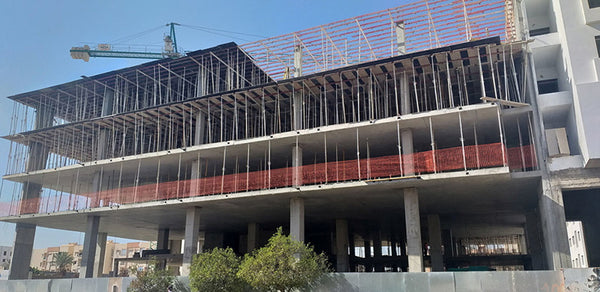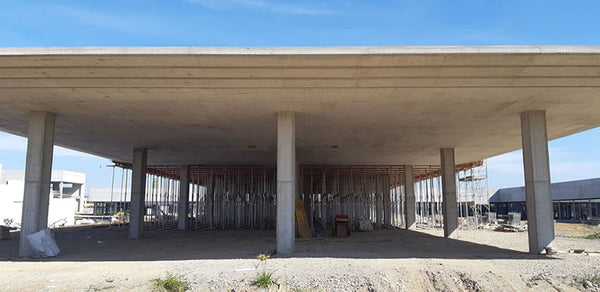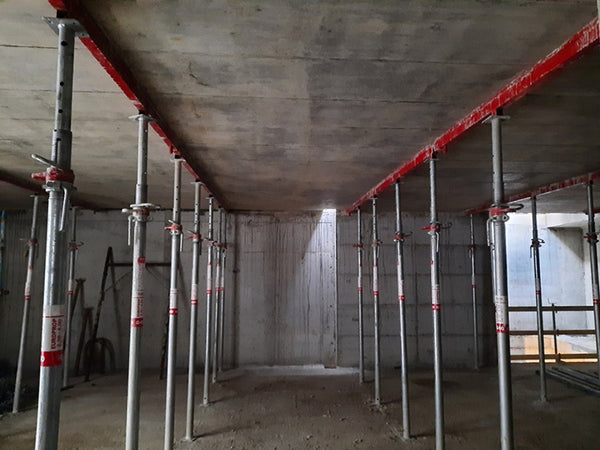FORMWORK FOR SLABS: SHORING, PARTIAL STRIPPING AND TOTAL STRIPPING
Forming slabs is a construction process in which you must pay close attention and take all necessary precautions.
If you work in the construction sector and you are going to start a project, it is important to study the execution process for your structure in depth, especially with regard to slabs or framework.
Formwork is the auxiliary structure that supports the load of the framework during the execution of the project. It is composed of a skin or formwork surface (deck panel) which rests on a resistant structure with a double level of beams that is in turn supported on supporting elements (props or framework), which make the formwork reach a certain height.
The fact that there are a great variety of heights in construction project means that the supporting elements the most critical. If we want to have complete control of the system, we must address the characteristics that the shoring must have in accordance with the different heights for each particular project.

What are the most important formwork actions in terms of slabs?
Basically, there are two actions: Shoring and Stripping
Shoring: This involves the placement of the shoring before concreting the slabs in accordance with the configuration required by the formwork system.

Stripping: This involves the removal of the shoring when the slab or framework has already acquired sufficient resistance to support the load resting on it at that moment. Stripping can be partial or total.

How can formwork be recovered?
You have likely come across construction managers that have not allowed you to recover any component of the formwork until the concrete is fully mature, or an engineer who associates the rapid recovery of the formwork with a critical operation that is normally detrimental to the structure.
Sometimes, speed in the construction process is seen as an insecure element for the structure.
Is that really true? Let’s find out!
When concreting a slab, we place liquid concrete on a formwork bed that contains it and gives it shape. Once the concrete is placed, it sets and hardens, becoming a rigid solid.
Is the hardening process fast or slow? The standards state that under normal conditions (20 ºC), three-day-old concrete has 40 percent of its final characteristic resistance.
If something has certainly happened to the slab over that period, it is that the concrete has ceased to be liquid and it is therefore no longer necessary to continue maintaining the formwork beds and part of its resistant structure.
Salvaging the formwork is a common sense action that enables us to optimize the equipment, using each component when strictly necessary.
When you delve into the analysis of the construction process, you realize that not only is stripping the structure not detrimental to it, but it is necessary and beneficial to be able to safely construct the building.
The fact that you can remove formwork and strip doesn’t you can do it any old way, it must be properly calculated and controlled.
Partial stripping and total stripping
What is partial stripping?
Partial stripping is the action in which not all shoring is removed at the same time, but over phases.
In the first phase after three days, you can remove the entire formwork surface (recovery) and part of its resistant structure, leaving beams separated two meters apart from one another with their respective props as supports for the slab, producing a CLEARING construction process. As this support span is much smaller than the span of the structure (6-7 meters), the strength required for the slab is low, generally 40% fck.
In the second phase, the shoring left as a support is removed when the concrete reaches 100% fck.
It is important to highlight that when partial stripping is carried out, the slab never ceases to be supported until the slab is fully resistant.

What is total stripping?
This involves a stripping action in which all the shoring is completely removed, leaving the slab to hold its entire weight on its own. As the slab won’t have any support, the required strength is higher than with partial stripping, and a reference estimate for it is at 65-70% fck for normal load and temperature conditions.
In buildings with successive floors in height, after having performed the total stripping, the slab will bear loads from the other floors above. Therefore we must aid it with post-shores that absorb the increased load that occurs, producing a constructive process of RE-SCAFFOLDING or RE-SHORING. This re-scaffolding equipment will be maintained until the concrete acquires 100% fck.
When can we do total stripping?
Above, we indicated as a reference that the resistance value required under normal conditions is around 65-70% fck, but its final value will depend on the calculation we make for the particular characteristics of each construction project.
